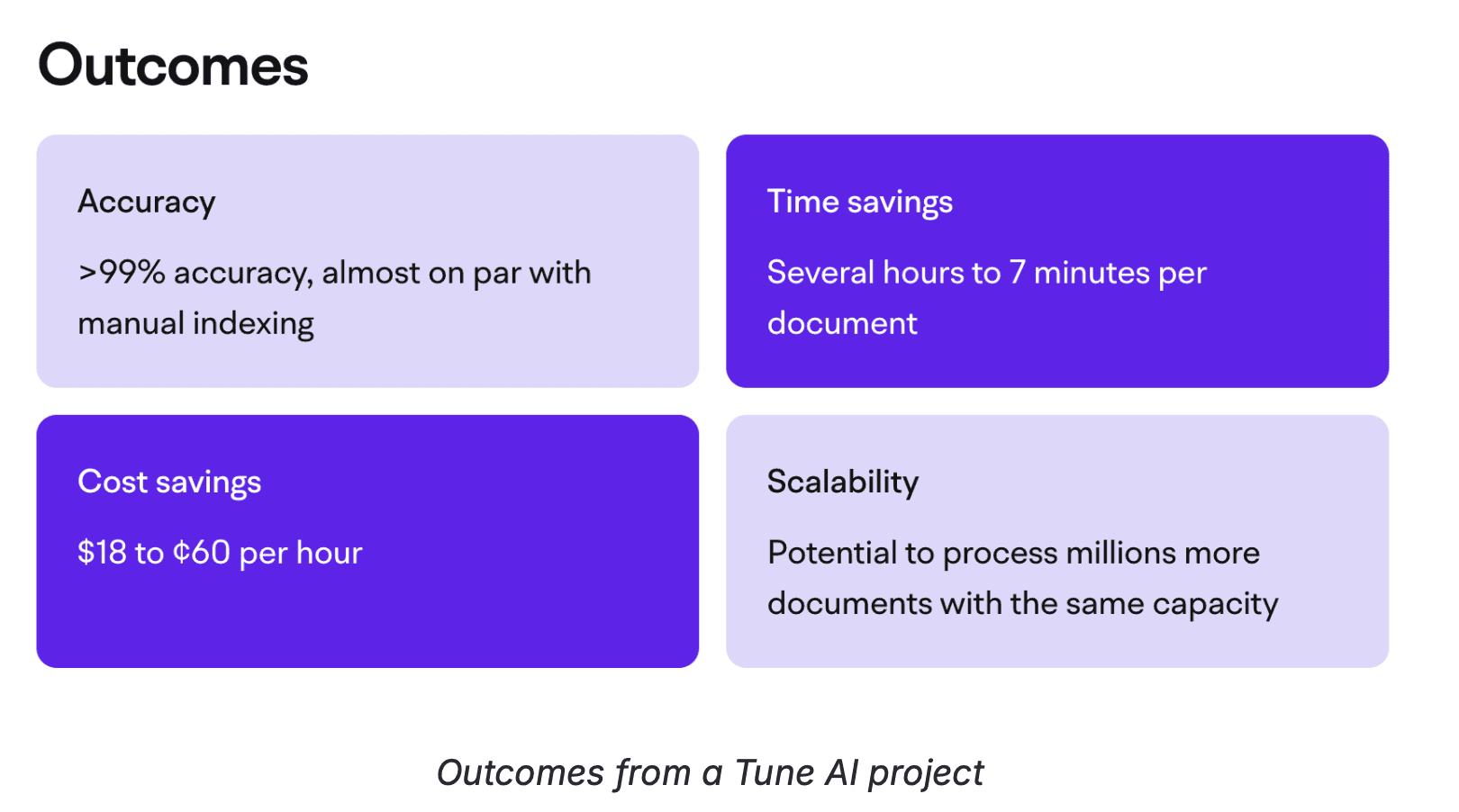Enterprise
Your Data, Your Models, Your Competitive Advantage
Sep 8, 2024
5 min read

In the digital transformation era of the 2010s, “every company is a tech company” was a common adage. What it really meant was that technology would be the competitive advantage for any business in the world. For instance, a dynamic and hyper-personalized e-commerce platform was a game-changer in retail. A digital twin created unmatched agility in the supply chain.
But the truth is: Every company has that today. The foundations of cloud, microservices, big data and analytics are already in place. So, what next?
We believe that the next springboard to technological innovation and competitive advantage will come from Generative AI. Here’s how.
Before we get into GenAI, let’s talk about what competitive advantage is. In a world of extreme competition, a business’s biggest differentiator is ‘how’ it does business. This could be an enviable customer service operation, a swashbuckling WWDC or a delight-to-use mobile app.
What could possibly be your competitive advantage?
Stellar customer experience
The Boston Consulting Group found just earlier this year that “Gen-Zers care more about the way they experience a brand than they do about snagging the lowest price or best promotion.”
As Gen-Z and Alpha become the biggest audience groups, unique experiences will bear more value for brands. Generative AI can help create those experiences, built on the insights from years of customer interactions.
Take, for instance, a GenAI shopping assistant on your mobile app or e-commerce website. It can take internal data, such as each customer’s purchase patterns, similar shoppers’ preferences, product information, etc. and combine that with external factors like the hit products of the season or the newest fashion trends.
Based on a combination of all these factors, your GenAI shopping assistant can make accurate hyper-personalized recommendations as part of an engaging conversation. Imagine the kind of experience you can create for a customer when the chatbot says, “the ‘medium’ in this brand is the same measurement as the ‘small’ of your favorite brand. So, keep that in mind.”
Chatbots, however, are the lowest-hanging fruit of the Generative AI tree. Let’s see what else it can do.
Process efficiency
At Tune AI, we are excited about approaching large language models (LLMs) as RPA 2.0. It doesn’t sound glamorous, yet, at every enterprise we’ve interacted with, leveraging LLMs for robotic process automation has found instant appreciation.
For instance, a multi-billion dollar business intelligence company implemented open-source LLMs to index PDF documents at scale. They went from manual data indexing, which took several hours for each PDF, to only 7 minutes with LLM-powered automation.

To be fair, you can add a chatbot on top of this indexed data for the subject matter experts to interface with. However, the competitive advantage created by model-customized GenAI is in the ability to efficiently, quickly, accurately and continuously index enormous amounts of unstructured data!
Language accessibility
Anyone who has ever tried building multilingual websites knows that translation is one of the biggest challenges. This is especially true when you have to translate into multiple languages while retaining the message, meaning, tone and voice of your brand.
Generative AI can help with that. Using the right models and meaningful customization, you can generate content across multiple languages at miraculous speeds.

However, as of today, Generative AI gives a robust starting point for translations. It eliminates the need to do everything word by word. It creates a base document that the human-in-the-loop can edit, adjust and bring to acceptable standards.
Over time, with reinforcement learning from human feedback, the LLM can do better, minimizing manual intervention dramatically.
Tech enablement
What if you can extend the ease and speed of low-code no-code tools to GenAI? Well, every CTO we’ve spoken with has only been excited by the idea. Business teams and citizen developers would do incredibly well to be able to develop simple, user-friendly, use case-driven GenAI apps on their own.
Imagine an HR associate spinning up a chatbot for FAQs about the new tax declaration policy. Or a marketer creating an app to automatically add the brand logo, in line with guidelines, on all creatives. Or the finance team building an app to automatically send payslips to everyone each month. All on your data!
Even a scrappy playground for building GenAI apps gives you the superpower to cook up what you need without joining the never-ending queue of requests to the engineering team!
If any of the above possibilities sounds like yet another multi-year project in ‘AI transformation,’ you must speak to one of Tune AI’s experts. With our purpose-designed tools and steadfast business focus, we’ve been able to take enterprises live within weeks. Here’s what we use:
Tune Chat: State-of-the-art GenAI platform that offers multiple models, a prompt library, file exploration capabilities and integrations for answers to all your questions. You can also adopt Tune Chat to meet your own needs and build a chatbot with it.
Tune Studio: Developer playground to build and ship GenAI apps with confidence. You can try any LLM, train on top-tier hardware, fine-tune with proprietary data and deploy as you please.
Expert consultants: Tune AI’s technologists, data scientists, and customer success managers work in close collaboration to ensure the LLMs are geared toward business outcomes.
In the digital transformation era of the 2010s, “every company is a tech company” was a common adage. What it really meant was that technology would be the competitive advantage for any business in the world. For instance, a dynamic and hyper-personalized e-commerce platform was a game-changer in retail. A digital twin created unmatched agility in the supply chain.
But the truth is: Every company has that today. The foundations of cloud, microservices, big data and analytics are already in place. So, what next?
We believe that the next springboard to technological innovation and competitive advantage will come from Generative AI. Here’s how.
Before we get into GenAI, let’s talk about what competitive advantage is. In a world of extreme competition, a business’s biggest differentiator is ‘how’ it does business. This could be an enviable customer service operation, a swashbuckling WWDC or a delight-to-use mobile app.
What could possibly be your competitive advantage?
Stellar customer experience
The Boston Consulting Group found just earlier this year that “Gen-Zers care more about the way they experience a brand than they do about snagging the lowest price or best promotion.”
As Gen-Z and Alpha become the biggest audience groups, unique experiences will bear more value for brands. Generative AI can help create those experiences, built on the insights from years of customer interactions.
Take, for instance, a GenAI shopping assistant on your mobile app or e-commerce website. It can take internal data, such as each customer’s purchase patterns, similar shoppers’ preferences, product information, etc. and combine that with external factors like the hit products of the season or the newest fashion trends.
Based on a combination of all these factors, your GenAI shopping assistant can make accurate hyper-personalized recommendations as part of an engaging conversation. Imagine the kind of experience you can create for a customer when the chatbot says, “the ‘medium’ in this brand is the same measurement as the ‘small’ of your favorite brand. So, keep that in mind.”
Chatbots, however, are the lowest-hanging fruit of the Generative AI tree. Let’s see what else it can do.
Process efficiency
At Tune AI, we are excited about approaching large language models (LLMs) as RPA 2.0. It doesn’t sound glamorous, yet, at every enterprise we’ve interacted with, leveraging LLMs for robotic process automation has found instant appreciation.
For instance, a multi-billion dollar business intelligence company implemented open-source LLMs to index PDF documents at scale. They went from manual data indexing, which took several hours for each PDF, to only 7 minutes with LLM-powered automation.

To be fair, you can add a chatbot on top of this indexed data for the subject matter experts to interface with. However, the competitive advantage created by model-customized GenAI is in the ability to efficiently, quickly, accurately and continuously index enormous amounts of unstructured data!
Language accessibility
Anyone who has ever tried building multilingual websites knows that translation is one of the biggest challenges. This is especially true when you have to translate into multiple languages while retaining the message, meaning, tone and voice of your brand.
Generative AI can help with that. Using the right models and meaningful customization, you can generate content across multiple languages at miraculous speeds.

However, as of today, Generative AI gives a robust starting point for translations. It eliminates the need to do everything word by word. It creates a base document that the human-in-the-loop can edit, adjust and bring to acceptable standards.
Over time, with reinforcement learning from human feedback, the LLM can do better, minimizing manual intervention dramatically.
Tech enablement
What if you can extend the ease and speed of low-code no-code tools to GenAI? Well, every CTO we’ve spoken with has only been excited by the idea. Business teams and citizen developers would do incredibly well to be able to develop simple, user-friendly, use case-driven GenAI apps on their own.
Imagine an HR associate spinning up a chatbot for FAQs about the new tax declaration policy. Or a marketer creating an app to automatically add the brand logo, in line with guidelines, on all creatives. Or the finance team building an app to automatically send payslips to everyone each month. All on your data!
Even a scrappy playground for building GenAI apps gives you the superpower to cook up what you need without joining the never-ending queue of requests to the engineering team!
If any of the above possibilities sounds like yet another multi-year project in ‘AI transformation,’ you must speak to one of Tune AI’s experts. With our purpose-designed tools and steadfast business focus, we’ve been able to take enterprises live within weeks. Here’s what we use:
Tune Chat: State-of-the-art GenAI platform that offers multiple models, a prompt library, file exploration capabilities and integrations for answers to all your questions. You can also adopt Tune Chat to meet your own needs and build a chatbot with it.
Tune Studio: Developer playground to build and ship GenAI apps with confidence. You can try any LLM, train on top-tier hardware, fine-tune with proprietary data and deploy as you please.
Expert consultants: Tune AI’s technologists, data scientists, and customer success managers work in close collaboration to ensure the LLMs are geared toward business outcomes.
In the digital transformation era of the 2010s, “every company is a tech company” was a common adage. What it really meant was that technology would be the competitive advantage for any business in the world. For instance, a dynamic and hyper-personalized e-commerce platform was a game-changer in retail. A digital twin created unmatched agility in the supply chain.
But the truth is: Every company has that today. The foundations of cloud, microservices, big data and analytics are already in place. So, what next?
We believe that the next springboard to technological innovation and competitive advantage will come from Generative AI. Here’s how.
Before we get into GenAI, let’s talk about what competitive advantage is. In a world of extreme competition, a business’s biggest differentiator is ‘how’ it does business. This could be an enviable customer service operation, a swashbuckling WWDC or a delight-to-use mobile app.
What could possibly be your competitive advantage?
Stellar customer experience
The Boston Consulting Group found just earlier this year that “Gen-Zers care more about the way they experience a brand than they do about snagging the lowest price or best promotion.”
As Gen-Z and Alpha become the biggest audience groups, unique experiences will bear more value for brands. Generative AI can help create those experiences, built on the insights from years of customer interactions.
Take, for instance, a GenAI shopping assistant on your mobile app or e-commerce website. It can take internal data, such as each customer’s purchase patterns, similar shoppers’ preferences, product information, etc. and combine that with external factors like the hit products of the season or the newest fashion trends.
Based on a combination of all these factors, your GenAI shopping assistant can make accurate hyper-personalized recommendations as part of an engaging conversation. Imagine the kind of experience you can create for a customer when the chatbot says, “the ‘medium’ in this brand is the same measurement as the ‘small’ of your favorite brand. So, keep that in mind.”
Chatbots, however, are the lowest-hanging fruit of the Generative AI tree. Let’s see what else it can do.
Process efficiency
At Tune AI, we are excited about approaching large language models (LLMs) as RPA 2.0. It doesn’t sound glamorous, yet, at every enterprise we’ve interacted with, leveraging LLMs for robotic process automation has found instant appreciation.
For instance, a multi-billion dollar business intelligence company implemented open-source LLMs to index PDF documents at scale. They went from manual data indexing, which took several hours for each PDF, to only 7 minutes with LLM-powered automation.

To be fair, you can add a chatbot on top of this indexed data for the subject matter experts to interface with. However, the competitive advantage created by model-customized GenAI is in the ability to efficiently, quickly, accurately and continuously index enormous amounts of unstructured data!
Language accessibility
Anyone who has ever tried building multilingual websites knows that translation is one of the biggest challenges. This is especially true when you have to translate into multiple languages while retaining the message, meaning, tone and voice of your brand.
Generative AI can help with that. Using the right models and meaningful customization, you can generate content across multiple languages at miraculous speeds.

However, as of today, Generative AI gives a robust starting point for translations. It eliminates the need to do everything word by word. It creates a base document that the human-in-the-loop can edit, adjust and bring to acceptable standards.
Over time, with reinforcement learning from human feedback, the LLM can do better, minimizing manual intervention dramatically.
Tech enablement
What if you can extend the ease and speed of low-code no-code tools to GenAI? Well, every CTO we’ve spoken with has only been excited by the idea. Business teams and citizen developers would do incredibly well to be able to develop simple, user-friendly, use case-driven GenAI apps on their own.
Imagine an HR associate spinning up a chatbot for FAQs about the new tax declaration policy. Or a marketer creating an app to automatically add the brand logo, in line with guidelines, on all creatives. Or the finance team building an app to automatically send payslips to everyone each month. All on your data!
Even a scrappy playground for building GenAI apps gives you the superpower to cook up what you need without joining the never-ending queue of requests to the engineering team!
If any of the above possibilities sounds like yet another multi-year project in ‘AI transformation,’ you must speak to one of Tune AI’s experts. With our purpose-designed tools and steadfast business focus, we’ve been able to take enterprises live within weeks. Here’s what we use:
Tune Chat: State-of-the-art GenAI platform that offers multiple models, a prompt library, file exploration capabilities and integrations for answers to all your questions. You can also adopt Tune Chat to meet your own needs and build a chatbot with it.
Tune Studio: Developer playground to build and ship GenAI apps with confidence. You can try any LLM, train on top-tier hardware, fine-tune with proprietary data and deploy as you please.
Expert consultants: Tune AI’s technologists, data scientists, and customer success managers work in close collaboration to ensure the LLMs are geared toward business outcomes.
Written by

Anshuman Pandey
Co-founder and CEO
